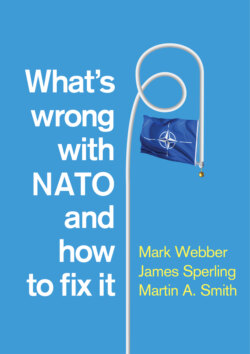Читать книгу What's Wrong with NATO and How to Fix it - Mark Webber - Страница 29
Imprecision
ОглавлениеNATO has found itself in hot water over enlargement, in part, because of a reluctance to define the policy’s limits. Admittedly, here it has faced a real predicament. Had NATO been too restrictive on enlargement’s scope after the Cold War (or even eschewed the policy altogether) it would have been accused of abandoning Eastern Europe, and plunging the region into a ‘grey zone’ of strategic uncertainty. The course it chose instead was expansive but ambiguous. The Alliance’s position on enlargement is formally subject to Article 10 of the North Atlantic Treaty, a clause that affords the possibility of membership to ‘any […] European State’. NATO, having now taken in a number of Balkan countries, much of former communist Eastern Europe and the Baltic States, has an ‘open door’ that hypothetically extends to the whole of the former Yugoslavia, European neutrals and the former Soviet republics of Transcaucasia (including Georgia), as well as Moldova, Belarus, Ukraine and even Russia. Within this elastic geopolitical context, NATO has exercised choice by imposing political, military and geostrategic preconditions. But conditionality has, in effect, entrapped the Alliance. Entry can be delayed, but it has denied itself the ability to foreclose membership as a matter of principle.69 This has given rise to some real predicaments. Georgia especially has taken every opportunity to solidify its relations with NATO. Its troops have served in Afghanistan and Kosovo, it has units assigned to the NATO Response Force, and its armed forces are engaged in all manner of NATO-approved defence assistance packages. Georgia has ‘nothing else left to prove’, according to the former commander of the US army in Europe.70 Yet, fearful of Russian reaction, the allies have been unwilling to provide Georgia with a Membership Action Plan (MAP). Enlargement, at least in this case, is at a ‘geopolitical impasse’. NATO remains formally committed to the process but unable or unwilling to execute it.71
NATO’s partnership policies have exhibited a similar ambiguity. Since the early 1990s, the Alliance has developed relations with over forty states, drawing upon a menu of some 1,400 separate partnership activities. These have undoubtedly had some benefits. PfP helped prepare post-communist states for NATO membership and fashioned close working relations with neutral states such as Finland and Sweden; the ‘strategic partnership’ with the EU has facilitated practical cooperation on issues such as cyber defence and military mobility; and individual partners have made important contributions to NATO exercises as well as to operations in Afghanistan, Libya and Kosovo. But some obvious failings have also been evident. NATO’s umbrella scheme, the Euro-Atlantic Partnership Council, has become too unwieldy to be useful, and regional initiatives such as the Mediterranean Dialogue and the Istanbul Cooperation Initiative have proven largely ineffectual. The Alliance’s attempts to rationalize its partnerships’ portfolio, meanwhile, have had only limited success. The overall impression is still one of unchecked institutional proliferation: ‘an accumulation of partly unconnected, partly overlapping formats’ sits alongside ‘antiquated practices’; new formats have failed to displace old ones; and multilateralism competes with special bilateral relationships or minilateral sub-groups.72 Partnership schemes also require coordination across several agencies. The sheer scale of that effort has exacted a significant toll upon NATO’s human and financial resources. Partnerships in the round, one former alliance official has suggested, have become ‘close to unmanageable’.73
